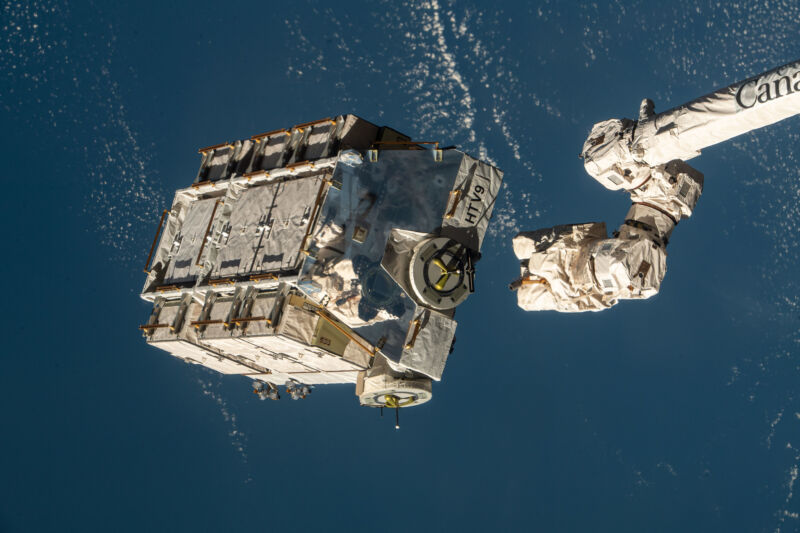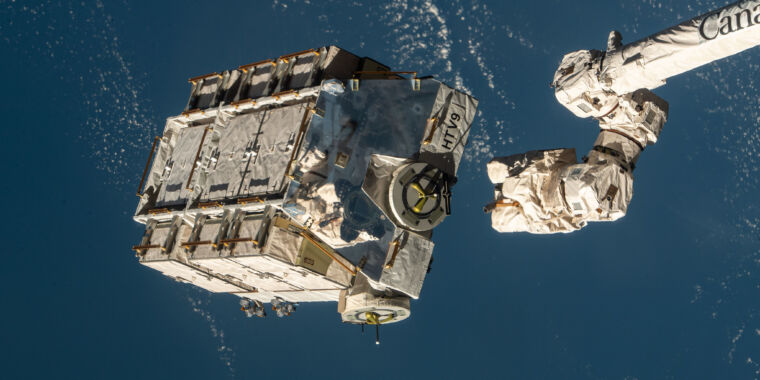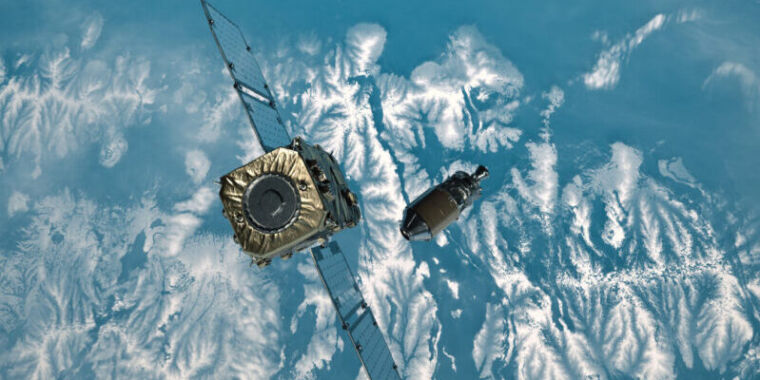A hunk of junk from the International Space Station hurtles back to Earth

Enlarge / In March 2021, the International Space Station’s robotic arm released a cargo pallet with nine expended batteries.
NASA
A bundle of depleted batteries from the International Space Station careened around Earth for almost three years before falling out of orbit and plunging back into the atmosphere Friday. Most of the trash likely burned up during reentry, but it’s possible some fragments may have reached Earth’s surface intact.
Larger pieces of space junk regularly fall to Earth on unguided trajectories, but they’re usually derelict satellites or spent rocket stages. This involved a pallet of batteries from the space station with a mass of more than 2.6 metric tons (5,800 pounds). NASA intentionally sent the space junk on a path toward an unguided reentry.
Naturally self-cleaning
Sandra Jones, a NASA spokesperson, said the agency “conducted a thorough debris analysis assessment on the pallet and has determined it will harmlessly reenter the Earth’s atmosphere.” This was, by far, the most massive object ever tossed overboard from the International Space Station.
The batteries reentered the atmosphere at 2: 29 pm EST (1929 UTC), according to US Space Command. At that time, the pallet would have been flying between Mexico and Cuba. “We do not expect any portion to have survived reentry,” Jones told Ars.
The European Space Agency (ESA) also monitored the trajectory of the battery pallet. In a statement this week, the ESA said the risk of a person being hit by a piece of the pallet was “very low” but said “some parts may reach the ground.” Jonathan McDowell, an astrophysicist who closely tracks spaceflight activity, estimated about 500 kilograms (1,100 pounds) of debris would hit the Earth’s surface.
“The general rule of thumb is that 20 to 40 percent of the mass of a large object will reach the ground, though it depends on the design of the object,” the Aerospace Corporation says.
A dead ESA satellite reentered the atmosphere in a similar uncontrolled manner February 21. At 2.3 metric tons, this satellite was similar in mass to the discarded battery pallet. ESA, which has positioned itself as a global leader in space sustainability, set up a website that provided daily tracking updates on the satellite’s deteriorating orbit.

Enlarge / This map shows the track of the unguided cargo pallet around the Earth over the course of six hours Friday. It reentered the atmosphere near Cuba on southwest-to-northeast heading.
As NASA and ESA officials have said, the risk of injury or death from a spacecraft reentry is quite low. Falling space debris has never killed anyone. According to ESA, the risk of a person getting hit by a piece of space junk is about 65,000 times lower than the risk of being struck by lightning.
This circumstance is unique in the type and origin of the space debris, which is why NASA purposely cast it away on an uncontrolled trajectory back to Earth.
The space station’s robotic arm released the battery cargo pallet on March 11, 2021. Since then, the batteries have been adrift in orbit, circling the planet about every 90 minutes. Over a span of months and years, low-Earth orbit is self-cleaning thanks to the influence of aerodynamic drag. The resistance of rarefied air molecules in low-Earth orbit gradually slowed the pallet’s velocity until, finally, gravity pulled it back into the atmosphere Friday.
The cargo pallet, which launched inside a Japanese HTV cargo ship in 2020, carried six new lithium-ion batteries to the International Space Station. The station’s two-armed Dextre robot, assisted by astronauts on spacewalks, swapped out aging nickel-hydrogen batteries for the upgraded units. Nine of the old batteries were installed on the HTV cargo pallet before its release from the station’s robotic arm.
A hunk of junk from the International Space Station hurtles back to Earth Read More »


